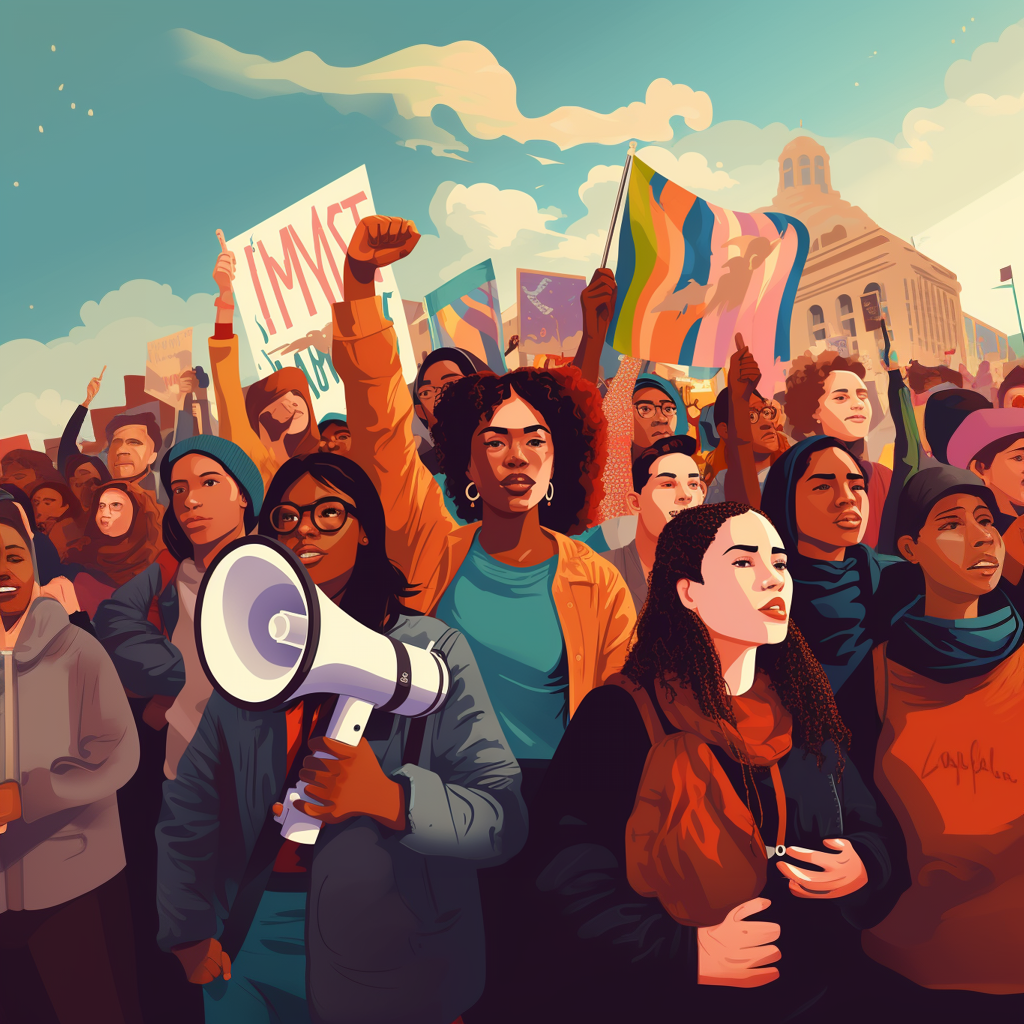
Grassroots Activism: Mobilizing Communities Behind Shared Goals
Grassroots activism can have immense political impact and lead the way for social change. Throughout history, grassroots movements have raised public support for important issues and led to the adoption of more inclusive, people-centered policies. Numerous organizations have had success stories in non-partisan grassroots mobilization, and their legacy carries on today.
What is Grassroots Activism?
Grassroots activism describes organized efforts by individuals, groups, or communities to address social, political, economic, or environmental issues. Grassroots activism is usually non-partisan, meaning it is not aligned with any political party. Grassroots movements strive to bridge differences within communities and rally support around shared goals.
Grassroots activism is a type of “bottom-up” democracy. This means it seeks broad support from the people, rather than from the elite. Grassroots movements often begin with conversations among a small group of friends, or even with the brave actions of a single person.
Grassroots movements can focus on a variety of issues, from environmental protection to civil rights. Common methods of mobilizing for these issues include:
Door-to-door canvassing
Protests, demonstrations, and marches
Petition drives
Contacting elected officials or local media outlets
Raising awareness through social media
Strategies like these allow ordinary citizens to make a real difference, empowering voices for change. These are also strategies we use at GoodParty.org to help advance more choices in our democracy!
Main Characteristics of Grassroots Activism
Grassroots activism is an impactful form of civic engagement and empowerment. Below are five main characteristics of effective grassroots movements:
Issue-Focused: Effective activism has specific and well-defined goals, focused on a particular issue.
Non-partisan: Strong grassroots movements bridge political divides and rally bipartisan support.
Inclusive: Local social challenges can best be overcome by welcoming a diverse range of perspectives.
Decentralized: Truly empowering grassroots activism spreads out control among the many people involved.
Transparent: Effective movements stay accountable through transparent decision-making processes and openness about their activities.
These characteristics are essential for movements that seek to create lasting change.
Strategies for Successful Community Mobilization
The most successful grassroots movements take strategic planning, open communication, and a strong follow-through. These steps can lay the groundwork for creating social change:
Define Your Message: Before you begin mobilizing or planning your first action, you’ll need to clearly define what you are fighting for. What is the specific issue your movement is seeking to address? How will you present that message to the world? Be sure to use inclusive and compelling language.
Organize Support: Begin finding others who are passionate about the same issue you are. Seek to gather a diverse group of people who can stand behind the cause. Be open to adjusting your methods as new supporters bring new perspectives.
Establish Strong Communication: Find a way for volunteers and supporters to communicate with one another — and for the movement to communicate with the world. Many grassroots organizations use social media to spread their message and raise awareness.
Plan Strategic Actions: Some grassroots movements culminate in large events, such as a protest or march, while others involve smaller actions over longer periods of time. Strategize by considering what kind of action will have the most political and social impact.
Empower Volunteers: Give volunteers ways to grow the movement. This could look like encouraging local groups to organize, giving volunteers clear steps for staying engaged in the campaign, or offering training and resources to keep the momentum going.
Each grassroots movement will have a slightly different path toward success. These steps can help to set the course as you dive into particulars.
Examples of Successful Grassroots Movements
Across the United States and around the world, grassroots activism has inspired significant social and political change. Within the United States, some of the most famous examples of community-driven initiatives include the women’s suffrage movement of the early 1900s and the Civil Rights Movement of the 1960s.
Both of these efforts led to societal transformation. The women’s suffrage movement gave white women the right to vote, leading to more equal representation in government. The Civil Rights Movement led to the passage of legislation like the Civil Rights Act of 1964, which outlawed racial discrimination in public spaces and made discrimination in employment illegal.
More recently, numerous examples of non-partisan activism have brought about change. Below are five success stories of grassroots initiatives that continue to have a lasting impact:
#1: Mothers Against Drunk Driving (MADD) - 1980 to present
On May 3, 1980, 13-year-old Cari Lightner was killed by a drunk driver in California. Her mother, Candace Lightner, began working to change the state’s drunk driving laws and prevent more families from experiencing the same tragedy. Other concerned mothers soon joined the movement Lightner had begun. By October of that same year, MADD held its first national press conference in Washington, D.C.
Since then, MADD has expanded nationwide and organized numerous actions in support of its cause, from candlelight vigils to youth summits. MADD has seen powerful improvements toward eliminating drunk driving-related fatalities. Here are some of the major milestones:
In 1984, President Ronald Reagan signed the minimum drinking age of 21 into national law.
In 1995, the Zero Tolerance policy became federal law, making it illegal for anyone under 21 to drive with any measurable amount of alcohol in their system.
In 2000, President Bill Clinton signed a federal law lowering the legal drunk driving limit to 0.08% blood alcohol content (BAC).
In 2021, the U.S. House of Representatives passed the Infrastructure Investment and Jobs Act. This act includes an “Advanced Impaired Driving Technology” section with mandates designed to prevent thousands of drunk driving-related deaths annually.
With a clear mission, powerful backstory, and widespread support, MADD is a noteworthy example of community mobilization that has created positive societal change.
#2: #MeToo - 2006 to present
In 2006, activist Tarana Burke founded the “me too.” Movement as a local, grassroots initiative. Her team began building resources and gathering a community to support survivors of sexual violence. In 2017, the hashtag #metoo went viral. The local movement quickly spread into a global one. Celebrities shared their stories of sexual harassment, particularly in the entertainment industry, and more survivors found their voices. Today, the organization continues to provide resources and community to survivors of sexual violence.
#3: Earth Hour - 2007 to present
Earth Hour began on March 31, 2007, when 2.2 million people in Sydney, Australia turned off their lights as a display that — despite what their government thought — people really did care about climate change. The next year, Earth Hour expanded to 35 countries. The year after that, in 2009, Earth Hour became the world’s largest grassroots movement for the environment.
In 2012, the initiative began to see tangible results. A campaign by Earth Hour led to Russia passing a law to better protect its seas from oil pollution. In the following years, Earth Hour’s impact spread. Nations like Uganda, Argentina, Malaysia, and Scotland took steps to protect natural resources and fight back against climate change. In 2022, over 190 countries and territories participated in Earth Hour.
Earth Hour built a global grassroots movement, but it began with local concerns. Earth Hour is an incredible example of a movement that has both grown exponentially and had a powerful political and social impact.
#4: Black Lives Matter (BLM) - 2013 to present
In 2013, Alicia Garza, Patrisse Cullors, and Opal Tometi founded #BlackLivesMatter in response to the acquittal of Trayvon Martin’s murderer. They set out to create “an ideological and political intervention in a world where Black lives are systematically and intentionally targeted for demise.” The following year, in 2014, the leaders organized a national ride to St. Louis in response to the killing of Mike Brown in Ferguson, Missouri. Following the gathering in St. Louis, Black Lives Matter chapters formed in 18 cities across the nation.
Today, Black Lives Matter is recognized worldwide. The organization has rallied support around numerous national policy issues, supported the arts, partnered with local leaders in frontline organizing, and more.
#5: March For Our Lives - 2018 to present
On February 14, 2018, a gunman entered Marjory Stoneman Douglas High School in Parkland, Florida and killed 17 people. In response, March For Our Lives organized the largest-ever single day of protest against gun violence. Millions of people mobilized to call for political action. March For Our Lives multiplied its impact by traveling around the United States to register new voters and collect the stories of survivors and community leaders.
In 2022, following more mass shootings, the organization led another march in Washington, D.C. Around the United States, over 450 sibling marches took place at the same time. The grassroots movement’s efforts helped lead to the passage of the federal Safer Communities Act and 20 state laws that have improved gun control. March For Our Lives is another example of a grassroots movement that has had powerful political influence.
How to Get Involved in Grassroots Activism
Becoming part of a grassroots movement can be as simple as finding a group or organization that has shared goals and objectives you admire, and getting connected. Many organizations have newsletters, social media, or local chapters to help get you plugged in. Connecting to a community is the first step to being part of a movement for change.
If any of the above initiatives stand out to you, there are plenty of ways you can get involved. You can look for a movement in your community that centers on local social challenges. You can also get involved with GoodParty.org to help fix the United States’ political dysfunction.
At GoodParty.org, we believe that people should matter more than money in our democracy. To that end, we help to make independent and third-party candidates a more viable option in local elections. You can become part of the movement by volunteering, joining our newsletter, or even exploring a run for office. We have both in-person and remote options to get you connected and involved. You have the power to make a difference!

